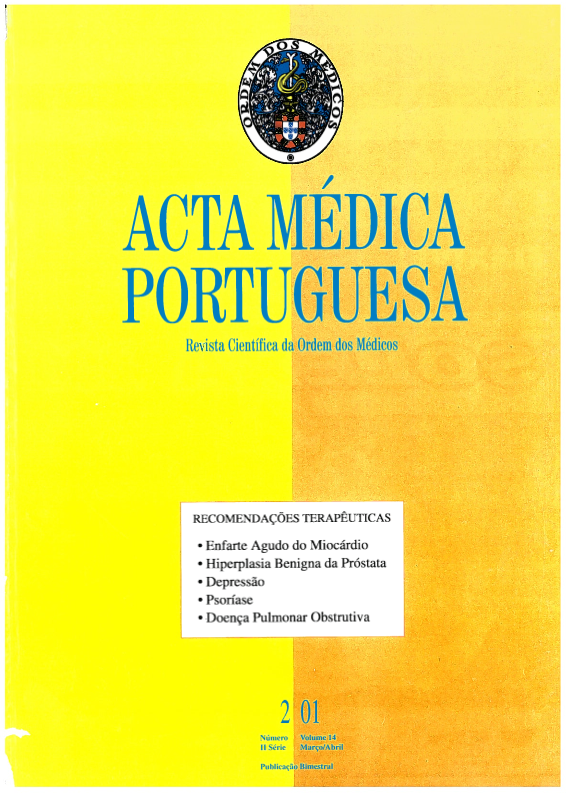Secondary prevention in acute myocardial infarction.
DOI:
https://doi.org/10.20344/amp.1839Abstract
Myocardial infarction is still one of the main causes of mortality and morbidity in Western countries. The advances made in the last 30 years have made it possible to reduce mortality significantly (which is currently below two digits) as well as morbidity. The subject of secondary prevention of myocardial infarction gains particular significance in this context since 10 to 15% of the patients who survive the hospital phase of myocardial infarction die during the first year following discharge and, of these deaths, half occur in the first three months. Therefore, it is necessary to make an early definition of the risk of another coronary event, that is, to make a risk stratification. This should occur throughout hospitalization and should be complete at the time of discharge, never beyond the first weeks of evolution. Bearing in mind the age, sex, coronary risk factors, ischemia persistence, the degree of left ventricular dysfunction and the presence of malignant disrhythmias, there are three risk levels: high; intermediate; and low. An overall approach to secondary prevention of infarction should take into account that, apart from the factors of such high prognostic value (Chapter II) assessed in the definition of risk groups, the measures to reduce reinfarction and sudden death (Chapter III) and the control of the risk factors for heart disease (Chapter IV) should also be considered. The principal late complications of infarction with significant prognostic influence are described in Chapter III: left ventricular dysfunction; rhythm disturbances and residual ischemia. The diagnostic criteria and therapeutic objectives are considered in each of the groups with relevance to consolidated advances according to the modern concept of evidence based medicine, according to international regulations. The grading of scientific evidence into three distinct categories (A, B and C), based on five levels of evidence classified from I to V, is presented accordingly in relation to the therapeutic proposals. Chapter III deals with a set of therapeutic interventions used in secondary prevention because they reduce reinfarction and sudden death: platelet antiaggregants; anticoagulants; Beta blockers; calcium channel blockers; antioxidants and nitrates. A concept of particular clinical significance is presented for each of these groups of drugs. The last part contains an eminently clinical overall review of the principal advances in coronary risk factor control, new therapeutic acquisitions in atherosclerotic disease with natural relevance to hypolipidemic agents and statins, which apart from controlling the plasmatic levels of cholesterol, also stabilize the atherosclerotic plaque and reduce acute coronary events significantly. Apart from dyslipidemia, the classic risk factors are: smoking; hypertension; obesity; diabetes and sedentary life. In each case, reference is made to the general measures and specific approaches, as well as the pharmacological therapy according to evidence based medicine. The recommended attitudes are pointed out. The role of cardiac rehabilitation and postmenopausal hormone replacement therapy are also discussed in the last part of these recommendations, in which the on-going controversy regarding hormone replacement therapy is pointed out in view of the results of more recent clinical trials.Downloads
Downloads
How to Cite
Issue
Section
License
All the articles published in the AMP are open access and comply with the requirements of funding agencies or academic institutions. The AMP is governed by the terms of the Creative Commons ‘Attribution – Non-Commercial Use - (CC-BY-NC)’ license, regarding the use by third parties.
It is the author’s responsibility to obtain approval for the reproduction of figures, tables, etc. from other publications.
Upon acceptance of an article for publication, the authors will be asked to complete the ICMJE “Copyright Liability and Copyright Sharing Statement “(http://www.actamedicaportuguesa.com/info/AMP-NormasPublicacao.pdf) and the “Declaration of Potential Conflicts of Interest” (http:// www.icmje.org/conflicts-of-interest). An e-mail will be sent to the corresponding author to acknowledge receipt of the manuscript.
After publication, the authors are authorised to make their articles available in repositories of their institutions of origin, as long as they always mention where they were published and according to the Creative Commons license.









